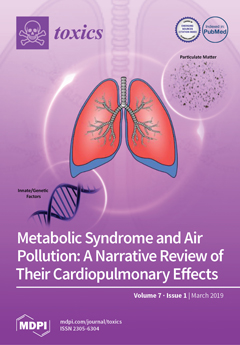It has been extensively demonstrated that plants accumulate organic substances emanating from various sources, including soil and water. This fact suggests the potentiality of contamination of certain vital bioresources, such as medicinal plants, by persistent contaminants, such as perfluorooctanoic acid (PFOA), perfluorooctane sulfonate
[...] Read more.
It has been extensively demonstrated that plants accumulate organic substances emanating from various sources, including soil and water. This fact suggests the potentiality of contamination of certain vital bioresources, such as medicinal plants, by persistent contaminants, such as perfluorooctanoic acid (PFOA), perfluorooctane sulfonate (PFOS), and perfluorobutane sulfonate (PFBS). Hence, in this study, the propensity of
Tagetes erecta L. (a commonly used medicinal plant) to accumulate PFOA, PFOS, and PFBS was determined using liquid chromatography/tandem mass spectrometry (LC–MS/MS-8030). From the results, PFOA, PFOS, and PFBS were detected in all the plant samples and concentration levels were found to be 94.83 ng/g, 5.03 ng/g, and 1.44 ng/g, respectively, with bioconcentration factor (BCF) ranges of 1.30 to 2.57, 13.67 to 72.33, and 0.16 to 0.31, respectively. Little evidence exists on the bioaccumulative susceptibility of medicinal plants to these persistent organic pollutants (POPs). These results suggest that these medicinal plants (in particular,
Tagetes erecta L., used for the management of diabetes) are also potential conduits of PFOA, PFOS, and PFBS into humans.
Full article






